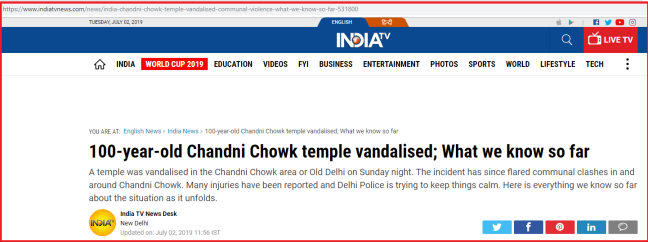In his book Pakistan or the Partition of India, Dr Bhimrao Ramji Ambedkar recalls the work of scholars who concluded that:
“Mahommad Ghori, one of the enthusiastic successors of Muhammad of Ghazni, in his conquest of Ajmir destroyed pillars and foundations of the idol-temples, and built in their stead mosques and colleges, and the precepts of Islam and the customs of the law were divulged and established. At Delhi, the city and its vicinity were freed from idols and idol worship, and in the sanctuaries of the images of the Gods mosques were raised by the worshippers of the one God.”
As an Indian Hindu, there is something about a broken temple in Delhi that brings out the worst of my civilizational memories.

You can see why.
A Hindu kid growing up in India soon becomes acutely aware of the centuries of humiliation heaped upon our ancestors. We hear stories from elders about the sacking and plunder of temples. Our history books dance around the topic, avoiding direct mention as far as possible, but they can’t whitewash everything. We do read about the Jaziya tax. We read about what happened to Somnath Temple. Not once, not twice, but several times over. We hear about the successive invasions of Delhi, the massacres, the plunder, the destruction of temples and the building of mosques over them.
If you have a little interest in history and digging up old books, you will read about the numbers of people killed in those massacres, the numbers of temples destroyed, the amount of the loot in gold, etc, etc. These have been recorded with pride (!) by the Islamic chroniclers who recorded the “glory” of the Sultans and Badshahs they served.
If you get to go around and see some of the proud symbols of India’s “Ganga Jamuni Tehzeeb,” you will be filled with a deep sense of humiliation. Not just at what happened, but at the way Hindu pain was buried and forgotten.
There was a picture of the Qutb Minar on the cover of one of my school history textbooks. Later I found out that the Qutb Minar and the adjoining Quwwat-ul-Islam mosque is built over the ruins of Hindu and Jain temples. I found out that Qutb Minar is not a symbol of Indian glory, but a victory tower built to celebrate the subjugation of our people. How do you think a Hindu kid feels?
Are you proud that ancient India was once home to the world’s greatest university? The ruins of Nalanda are in Bakhtiarpur in Bihar, with the town still named after the man who destroyed Nalanda University.
Of course, all of this is history. The people who did these things are no longer alive. We cannot change history; we must take it as it is; good, bad or ugly. But when a deep civilizational wound is scratched, the heart bleeds.
The incident in Chandni Chowk, in the heart of Delhi, in today’s India, causes a deep pain. It reminds us of the humiliation that our ancestors suffered for being Hindus in India.
Two things need to happen immediately.
First, the Government of India needs to act and swiftly so to put every one of those rioters behind bars. On this ,there can be no compromise. It is the least that we citizens expect from PM Modi and Home Minister Amit Shah, who is directly in charge of law and order in the National Capital Territory of Delhi.
Secondly, we Hindus need to speak up in one voice. Our ancestors had no voice and no rights. But we do. We live in a democracy. We can demand our dignity. We want justice.



